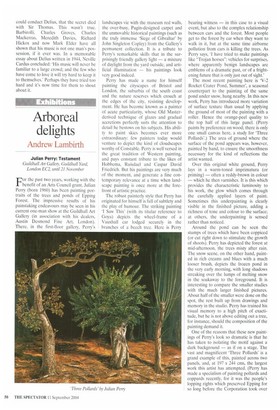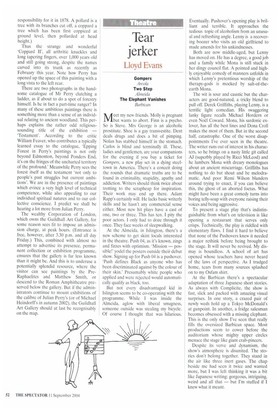Arboreal delights
Andrew Lambirth
Julian Perry: Testament Guildhall Art Gallery; Guildhall Yard, London EC2, until 21 November
uor the past two years, working with the 1 benefit of an Arts Council grant, Julian Perry (born 1960) has been painting portraits of the trees and ponds of Epping Forest. The impressive results of his painstaking endeavours may be seen in his current one-man show at the Guildhall Art Gallery (in association with his dealers, Austin Desmond Fine Art, London). There, in the first-floor gallery, Perry's
landscapes vie with the museum red walls, the over-busy, Pugin-designed carpet and the unmovable historical paintings (such as the truly immense 'Siege of Gibraltar' by John Singleton Copley) from the Gallery's permanent collection. It is a tribute to Perry's remarkable skills that in the surprisingly friendly gallery light — a mixture of daylight from the yard outside, and artificial illumination — his paintings look very good indeed.
Perry has made a name for himself painting the cityscapes of Bristol and London, the suburbia of the south coast and the nature reserves which crouch at the edges of the city, resisting development. He has become known as a painter of acute particularity, whose Old Masterderived technique of glazes and gradual accretions perfectly suits the attention to detail he bestows on his subjects. His ability to paint skies becomes ever more extraordinary: few painters today would venture to depict the kind of cloudscapes worthy of Constable. Perry is well versed in the great tradition of Western painting, and pays constant tribute to the likes of Hobbema, Ruisdael and Caspar David Friedrich. But his paintings are very much of the moment, and generate a fine contemporary relevance at a time when landscape painting is once more at the forefront of artistic practice.
The robust painterly style that Perry has originated for himself is full of subtlety and the play of humour. The striking painting 'I Saw This' (with its titular reference to Goya) depicts the wheel-frame of a Vauxhall car lodged securely in the branches of a beech tree. Here is Perry bearing witness — in this case to a visual event, but also to the complex relationship between cars and the forest. Most people get to the forest by car when they want to walk in it, but at the same time airborne pollution from cars is killing the trees. As Perry says, 'I have tried to make paintings like "Trojan horses": vehicles for surprises, where apparently benign landscapes are emblems of a dramatic past, or of a frightening future that is only just out of sight.'
The most recent painting here is `V-2 Rocket Crater Pond, Summer', a seasonal counterpart to the painting of the same pond under snow, hung nearby. In this new work, Perry has introduced more variation of surface texture than usual by applying the ground of most of the painting with a roller. Hence the orange-peel quality to the top half of this large panel. (Perry paints by preference on wood; there is only one small canvas here, a study for 'Three Pollards'.) The area of ground where the surface of the pond appears was, however, painted by hand, to ensure the smoothness necessary for the kind of reflections the artist wanted.
Over this original white ground, Perry lays in a warm-toned imprimatura (or priming) — often a reddy-brown in colour — which he then varnishes. It is this which provides the characteristic luminosity to his work, the glow which comes through the carefully applied layers of paint. Sometimes this underpainting is clearly visible in the finished picture, adding a richness of tone and colour to the surface; at others, the underpainting is sensed rather than noticed.
Around the pond can be seen the stumps of trees which have been coppiced (or cut right down to stimulate the growth of shoots). Perry has depicted the forest at mid-afternoon, the trees misty after rain. The snow scene, on the other hand, painted in rich creams and blues with a much looser brush, depicts the frozen pond in the very early morning, with long shadows streaking over the lumps of melting snow in the soakaway to the foreground. It is interesting to compare the smaller studies with the much larger finished pictures. About half of the smaller were done on the spot, the rest built up from drawings and memory in the studio. Perry has trained his visual memory to a high pitch of exactitude, but he is not above editing out a tree, for instance, should the composition of the painting demand it.
One of the reasons that these new paintings of Perry's look so dramatic is that he has taken to isolating the motif against a dark background — as if on a stage. The vast and magnificent 'Three Pollards' is a grand example of this, painted across two panels, and, at 197 x 244 ems, the largest work this artist has attempted. (Perry has made a specialism of painting pollards and coppards recently, for it was the people's lopping rights which preserved Epping for so long before the Corporation took over responsibility for it in 1878. A pollard is a tree with its branches cut off, a coppard a tree which has been first coppiced at ground level, then pollarded at head height.) Thus the strange and wonderful `Coppard II', all arthritic knuckles and long tapering fingers, over 1,000 years old and still going strong, despite the names carved into its trunk as recently as February this year. Note how Perry has opened up the space of this painting with a long vista to the left rear.
There are two photographs in the handsome catalogue of Mr Perry clutching a ladder, as if about to do a spot of forestry himself. Is he in fact a part-time ranger? In many of these ambitious paintings there is something more than a sense of an individual relating to ancient woodland. This perhaps explains the rather odd religioussounding title of the exhibition — 'Testament'. According to the critic William Feaver, who contributes a typically learned essay to the catalogue, 'Epping Forest in Perry's paintings is not only beyond Edmonton, beyond Ponders End, it's on the fringes of the uncharted territory of the profound.' Meanwhile Perry sees the forest itself as the testament 'not only to people's past struggles but current ambitions'. We are in the presence of paintings which evince a very high level of technical competence, while also appealing to our individual spiritual natures and to our collective conscience. I predict we shall be hearing a lot more from Julian Perry.
The wealthy Corporation of London, which owns the Guildhall Art Gallery, for some reason sees fit to impose an admission charge, at peak hours. (Entrance is free, however, after 3.30 p.m. and all day Friday.) This, combined with almost no attempt to advertise its presence, permanent collection or exhibition programme, ensures that the gallery is far less known than it might be. And this is to underuse a potentially splendid resource, where the visitor can see paintings by the PreRaphaelites and Matthew Smith, or descend to the Roman Amphitheatre preserved below the gallery. But if the administrators continue to mount exhibitions of the calibre of Julian Perry's (or of Michael Heindorffs in autumn 2002), the Guildhall Art Gallery should at last be recognisably on the map.











































































 Previous page
Previous page